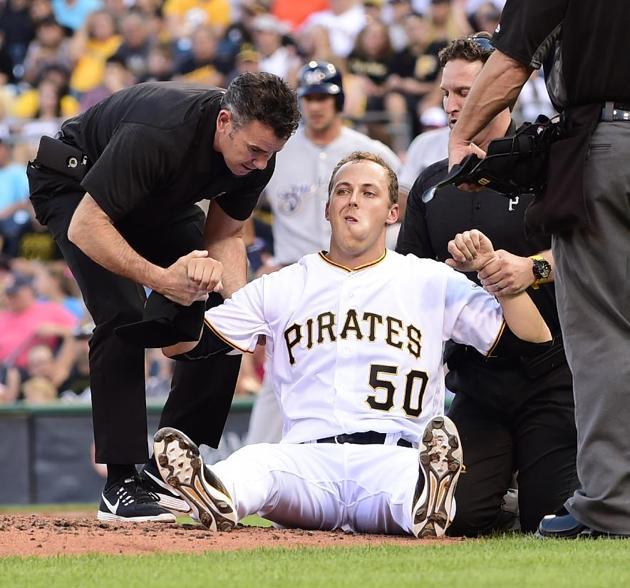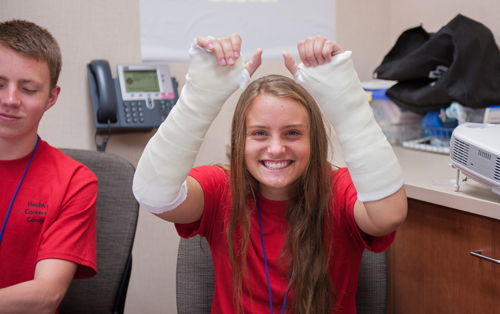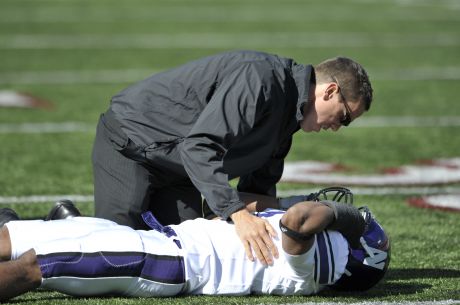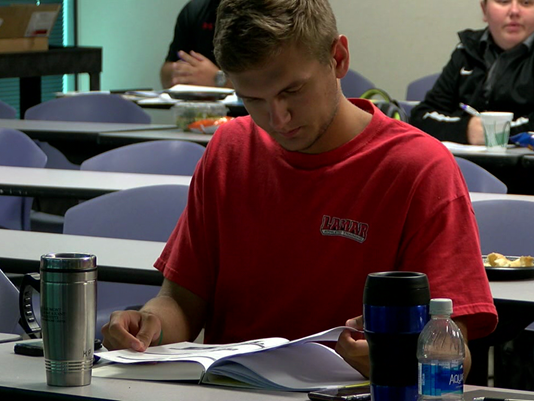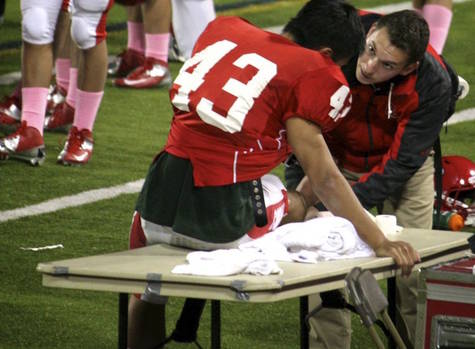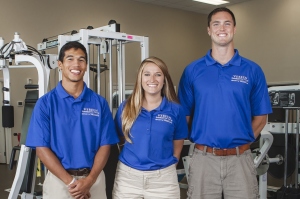
Article reposted from UWBadgers.com
Author: Andy Baggot
It all began with a familiar pose: A man sitting on his living room sofa watching sports on TV.
Tim Ehlers was relaxing at his home in Tomah, tuned into a Wisconsin men’s basketball game, when he saw something that piqued his professional curiosity.
Ehlers, a staff sergeant and medical training instructor for the Wisconsin Army National Guard, watched as longtime UW athletic trainer Henry Perez-Guerra came onto the court to tend to an injured player.
“Henry quickly evaluated a guy who had an ankle injury and it was a matter of 45 seconds and they had him up and were taking him off the floor,” Ehlers recalled. “I thought to myself, ‘Why can’t my medics do that in the field?'”
Ehlers, an Army medic for seven years, began to organize his thoughts and devise a plan of action for his volunteer charges.
“Over the past 15-ish years now we’ve been at war and we’ve learned great lessons about trauma medicine,” he said. “We pound into their head every year ‘trauma, trauma, trauma.’ They can treat people with missing arms, legs, shot in the chest.
“But when it comes to the fundamentals of simple clinical skills — how do we evaluate a sprained knee or a sprained ankle or a shoulder or back injury — we don’t have a set training plan on how to execute those skills.”
So Ehlers, a 37-year-old who grew up in Hudson, contacted Denny Helwig, the assistant athletic director for sports medicine at Wisconsin, in December of 2014.
In an email, Ehlers outlined how the two staffs — medics from the Wisconsin Army National Guard and UW Sports Medicine personnel — take a similar approach to diagnosing and treating concussions.
“I’m looking for an environment where I can teach my medics clinical skills, but put them in an environment where they’re going to learn,” Ehlers wrote.
“The more Tim and I talked about it — the medic training and our training — we thought it would be a good way for their people to come down and observe,” Helwig said. “The same people pulling from the same resources in terms of care for concussions and it went on from there.”
For the better part of a year, UW Athletics and the Wisconsin Army National Guard have been working together to improve their instincts and vital handiwork.
There have been multiple exchanges of personnel — UW athletic trainers trekking to Fort McCoy and Army medics volunteering to come to Madison — all under the guise of education.
The biggest chapter in that process is being written throughout August as the Badgers stage their preseason football camp at Camp Randall Stadium.
UW athletic trainer Kyle Gibson, one of the exchange coordinators, said 13 Army medics will come in small groups to observe one of the more strenuous periods for medical attention by the UW sports medicine personnel.
“That’s when we see a lot of injuries,” he said of the three-week training camp, which includes five two-a-day practice sessions. It began Aug. 8 and runs through the season opener Sept. 3.
The month-long exercise comes on the heels of two trips to Fort McCoy, located just west of Tomah, by UW athletic trainers.
Four went up in the first wave “and they came back with rave reviews on how realistic it is,” Gibson said, describing how $120,000 mannequins can have their heart rates and blood flow altered based on the treatment circumstances.
The second group, including Gibson, Perez-Guerra and Michael Moll, the primary athletic trainer for football, visited Fort McCoy and provided an overview on evaluation techniques to 160 medics.
“We’re not making them into athletic trainers; they’re not making us into medics,” Helwig noted. “It’s just an information-sharing situation.”
Helwig said the program that began with a discussion on shared concussion protocol is evolving into something much bigger.
“We realized that a lot of their training is in trauma — as you could imagine — and not so much in some of the, if you will, minor things like sprains and strains and things like that,” he said. “We occasionally deal with trauma, but not to the extent that they do.
“The whole thought was that we could help them understand a little bit better how to look at an ankle sprain, how to look at a muscle strain so that they can work with their people.
“We’re both interested in performance, obviously. Ours is on the field or court or whatever. Theirs is performance in the (battle) field.”
There are other similarities. Athletic trainers and medics share a like — read: stressful — evaluation process in the field. They both have a chain of command involved in every decision. They also become emotionally invested in their patients.
“We live in a what-if type of life where, ‘What if this happens? Are we prepared? Have we done the training that we need to do to be prepared?'” Gibson said.
There’s a major difference, though.
“They’re dealing with life-and-death situations and major trauma,” Moll said of the medics. “We’re dealing with on-the-field injuries, which can be significant, but really, it’s a matter of us trying to get guys back as quickly and safely as possible.”
Not only are medics dealing with mortal injuries, their lives are often at risk.
“It gives us perspective that, hey, this is really just football,” Moll said. “It’s important to everyone, but it’s much different.”

“We live in a what-if type of life where, ‘What if this happens? Are we prepared? Have we done the training that we need to do to be prepared?'” said Gibson (left).
Ehlers, who was deployed as a senior medic to Afghanistan in 2012 and ’13, said the teaching format grabs the attention of his charges who might otherwise be cavalier about the experience.
“You don’t see ACL, MCL (knee) injuries sitting in a hospital somewhere,” he said. “But you do see it out at training events.”
Such as a high-profile football practice where the participants and their efforts make headlines. In addition to injuries, medics will see UW sports medicine personnel initiate preventative care before practice and the after-care when the daily session is over.
“You put them in an environment like this where they’re seeing the people they look up to — you don’t get a chance to interact with a T.J. Watt or a Vince Biegel or people like that,” Ehlers said.
The cooperative plan calls for another rotation of medics to come to town in November to spend time with the men’s basketball team and in January to observe UW athletic trainers at work with men’s hockey. Visiting parties are there strictly to observe and ask questions.
“It’s a great educational experience for my soldiers to come down (to Madison) and learn,” Ehlers said.
All in all, it took 23 months for this idea to go from planting to harvest.
“It started with a conversation with my leadership,” Ehlers said. “I asked if I could do it. They said, ‘It’s your baby. If you want to make it happen, try and make it happen.'”
Along the way, Ehlers met with football coach Paul Chryst and UW Director of AthleticsBarry Alvarez and got their blessings.
“They all have gone out of their way of saying they’re in full support of having these medics come down here and interact with their players and learn,” Ehlers said, adding UW officials have been “absolutely amazing” in their support of the project.
“It’s a lot of time and effort, but it’s going to be 100-percent rewarding when I see my soldiers finally get to start rolling through this fall,” Ehlers said.
Helwig described Ehlers as “an honest, straight-forward guy who obviously, genuinely cares for what he does.”
According to Ehlers, there is no monetary investment from either party.
“It’s just a partnership based on mutual respect,” he said.
When Ehlers was in Afghanistan in late 2012, the base was visited by a group of touring NFL players. One was J.J. Watt, a former UW standout who now stars for the Houston Texans.
At one point, Ehlers approached Watt, shook his hand and thanked him for all he’s done on behalf of Wisconsin.
Fast forward to the spring of 2016. Ehlers was attending a UW spring practice session at the McClain Facility. By chance, so was Watt, a Pewaukee native whose brothers, Derek and T.J., followed him to Wisconsin.
Ehlers again approached J.J., who instantly recalled their first meeting. A brief photo session ensued.
It’s funny what can happen when a good idea takes wings.
“It’s a milestone in my career to build a partnership with the University of Wisconsin and the Wisconsin Army National Guard,” Ehlers said.
The payback goes in both directions.
“This way we can do some very good community service,” Helwig said.
“I think it’s a great program because anytime we can give back as civilians to the military, we look for those opportunities,” Gibson said.
“We can learn from them. They can learn from us. It’s a no-brainer of a program.”


